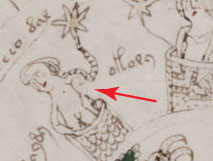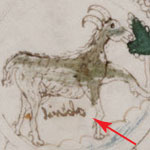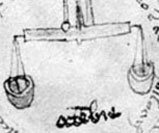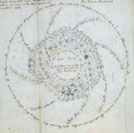Leonardo da Vinci and the Voynich Manuscript
Wilfred M. Voynich purchased the Voynich Manuscript from a Jesuit Monastery in Northern Italy in 1912. It is currently in the Beinecke Rare Book Library of Yale University. This Manuscript was made from soft light brown vellum and is considered to be approximately 500 years old. It consists of about 200 pages made up of drawings of plants, astronomical and astrological pictures and biological drawings that appear related to the human reproductive process. The text is in a cipher that has puzzled scholars and cryptographers for nearly a century. Although I have not been able to decipher more than a few words of this strange document, I think that the following observation relating to its authorship may aid others in reading it.
My initial exposure to the manuscript was a brief article by Alfred Werner in a 1962 issue of Horizon magazine. When I first read the article, I was immediately intrigued by the similarity of the script to that of Leonardo da Vinci, a fact also noted in 1975 by the son of Robert S. Brumbaugh.(1) An astrological chart representing the sign of Aries with fifteen nude little ladies sitting in tubs attracted my attention (Figure 1). A cousin, who is an antique dealer, told me that the tubs probably represented birthing tubs that were in use during medieval times to help in the delivery of a baby. Most of the ladies look rather pregnant. Closer examination of the drawing showed that this suggestion of birthing tubs is probably correct. A baby appears in the tub indicated by an arrow (enlarged in upper left corner of Figure 1) and the lady no longer looks pregnant. This tub also stands out because the lady is holding a striped string with the star on the end while all the other ladies are holding plain strings. Incidentally if you type “birthing tub” into a search engine on the internet you will find a number of advertisements for birthing tubs that are again becoming popular.
It did not require a great stretch of the imagination to arrive at the conclusion that this drawing may represent the chart of an individual born in the evening (stars) on the 15th (15 little ladies) of April (Aries the Ram). The birth occurred some time between 9pm and midnight (the tub with the baby lies midway between the 9 and 12 position on a current clock face). During medieval times, the new day began with sunset, a time that changed with the changing of the seasons. Simple mechanical clocks had been invented, but only a single hand was used to represent the hour and the dial had 24 hours beginning at midnight. Clocks were too inaccurate to warrant the use of minutes. This individual, if this hypothesis is correct, may have been born about 10 to 11 pm on the 15th of April.
Who was this mysterious individual? Well, his name is written under the sign of the Ram and looks like ob…l, but wait look at that name in the mirror or better still Xerox the picture and look at its reverse in the light and as Figure 2 (the mirror image of figure 1) indicates, the name may be Lionardo. The “r” is added above the name. This tends to support my observation that the writing is similar to that of Leonardo da Vinci who spelt his name Lionardo not Leonardo.
Figure 3 shows a comparison of this signature, direct and mirror image, with an authentic signature of Leonardo da Vinci, also direct and mirror image.(2) The similarity is apparent but a writing expert would be required to confirm this. In addition there could have been the passage of a number of years between the two signatures, accounting for variations in the letters. The chart signature was written in mirror image writing while the other was not. I also show a drawing of a deer taken from one of Leonardo’s picture puzzles. There is a similarity between this drawing and the ram in the Aries chart.
Further confirmation comes from Leonardo’s grandfather’s record of his birth and baptism in 1452: “A grandson of mine was born, son of Ser Piero my son, on April 15, Saturday at three o’clock in the night. His name was Lionardo…” According to the calendar of those times, the time was 22.30.(3) A careful study of Figure 2 will show that there is a date of 1452 on the tub with the baby and the only words I have been able to decipher from the mirror image of this chart are the words “sabatto notto,” Saturday night! Figure 4 shows enlargements of the tub and the script. These additional observations more or less confirm that the author of the Voynich manuscript was probably Leonardo da Vinci. Both Leonardo da Vinci and the individual from the chart were born in 1452 on the 15th April, a Saturday night, between 10 to 11 pm. This can hardly be a coincidence.
The picture shown in Figure 1 was the first of the pair of astrological charts in Z3610559, downloaded from the Yale University, Beinecke rare Manuscripts Library web site. It was loaded into Photoshop where it was converted from RGB to gray scale to increase the pallet size and the contrast enhanced using auto levels. The mirror image was obtained using the horizontal flip option. There was no further manipulation of the image except for cropping and enlarging parts of the picture. Anyone with a computer, access to the Internet and Photoshop can therefore repeat the above images. The other astrological chart that is part of Z3610559, is also an Aries chart with 15 little ladies and a couple of decorative squares indicating about the same time of night as the tub with the baby. The mirror image of the name under the ram also looks like Lionardo. Unfortunately Z3610559 is one of the poorest of the scans that the Beinecke Library offers the public. Most of the others are pretty good and it is to be hoped that this one can be improved. Never the less it is good enough to show the points I am trying to make and I am grateful that the Beinecke Library has taken the trouble to share the Manuscript with the rest of the world. If you have trouble accessing the pictures, call the Library up. They are extremely helpful.
I am not suggesting that a mature Leonardo wrote this manuscript; in fact it appears for the following reasons to be the work of a very precocious child rather than a mature adult.
- According to the botanical experts the flowers and root systems of some of the plants do not match. This is an error that a child is likely to make.
-
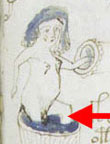 Figure 5
Full Image
The biological drawings have a childlike quality. One drawing, s3724838 (Figure 5), shows one of the little ladies, as the arrow indicates, with both breasts and male genitalia. This is hardly an adult error. This picture also depicts the union of a sperm with an ova, indicating an extraordinary insight into human reproduction. The author of these pictures was however unfamiliar with human female anatomy, but had probably observed the dissection of a female dog or pig. Leonardo da Vinci’s drawings of a fetus are extraordinary and as an adult he would not have made this type of error.
Figure 5
Full Image
The biological drawings have a childlike quality. One drawing, s3724838 (Figure 5), shows one of the little ladies, as the arrow indicates, with both breasts and male genitalia. This is hardly an adult error. This picture also depicts the union of a sperm with an ova, indicating an extraordinary insight into human reproduction. The author of these pictures was however unfamiliar with human female anatomy, but had probably observed the dissection of a female dog or pig. Leonardo da Vinci’s drawings of a fetus are extraordinary and as an adult he would not have made this type of error.
- The drawing is outstanding for a child but only adequate for an adult.
This is not the only drawing in the manuscript indicative of mirror image writing or drawing. There are a number of other astrological charts representing other signs of the zodiac. I have cropped some of the pictures and put the sign and the name under it into Figure 6, together with my interpretation of the name. The handwriting of some of the names is different and not all the names are written in mirror image script. As nothing is known about Leonardo’s childhood it is difficult for me to correlate them with his early life. The drawing depicting Gemini is interesting in that it depicts a man and woman dressed in garments typical of the 15th century Italy. In the astronomical drawing of the Milky Way, the stars travel through the night sky in a clockwise direction (Figure 7). As the stars rise in the sky in the East and set in the West, traveling in a counter clockwise direction, this drawing is a mirror image of what actually takes place.(4) Leonardo is famous for is his mirror image writing and drawing and is probably unique in the use of this idiosyncrasy.
What about the cipher? Most of the manuscript was written from top to bottom and from left to right. I am sure that even during the 15th century, a left handed child was encouraged to conform to the requirements of a right handed world and write in a conventional way. However it appears that mirror image writing was a dominant characteristic even during Leonardo’s childhood as the astrological and astronomical charts indicate. The few words I have been able to decipher are in Italian, but I am no linguist and cannot read modern Italian let alone 15th century Tuscany dialect, without the aid of a dictionary! A number of the words in the manuscript appear to be repetitive so I assume that they are only there to confuse the reader and have nothing to do with the actual text. The remaining words may involve simple substitution of letters for example “cc” represents “on.” The first few words in s3724838 (Figure 8), looks like Feccccdo etc. but could be Fecondo ????? dama uretra. This is in accordance with the content of the drawing.
What do the experts say about the dating of the manuscript?
- Hugh O’Neill of the Catholic University has identified one of the botanical drawings as an American sunflower. Since Sunflowers are native to the Americas they would not have been seen in Europe much earlier than the 1500’s. I am not a botanist, but this drawing could just as well represent an artichoke, which is native to southern Europe.(5)
- A medieval herbal expert, Sergio Toresella, considered that the Voynich Manuscript was written in a script fitting with the Italian humanist movement and should be dated around 1460.
- Renaissance Art expert, Erwin Panofsky, suggests that the manuscript is from the 1470 and originated in Germany.
- John Manly suggests that the quire signatures date from the 15th century.
- Dr. Robert Babcock thinks that the way the vellum was prepared dates it to the 16th century.(6)
Most of the experts indicate that the manuscript dates to the second half of the 15th century. I postulate that Leonardo da Vinci wrote the Voynich Manuscript circa 1460 when he was about 8 years old. If I am correct Yale University has a very valuable manuscript that should be of great interest to Leonardo da Vinci scholars.
- ↑ back The Most Mysterious Manuscript, edited by Robert S. Brumbaugh, Southern Illinois University Press, 1978, p 117.
- ↑ back The unknown Leonardo, ed. Reti L. McGraw Hill Book Company, New York, 1974, p.57.
- ↑ back Leonardo da Vinci, Reynal & Company, New York, 1956, p.7
- ↑ back I am grateful to Big Jim and his web site for pointing this out.
- ↑ back I am grateful to Stolfi’s web site for pointing this out.
- ↑ back These observations were taken from the web site geocities.com/voynichms/origin.
